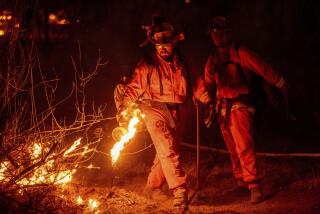State Bans Pornography in Prisons
SACRAMENTO — State prison officials have banned convicts from receiving pornographic magazines and all snapshots, drawings or other depictions of frontal nudity.
The ban, which excludes prison-approved artistic and educational material, followed complaints from female guards who found the materials offensive.
Prison authorities said some inmates have harassed female officers with suggestive comments or by masturbating in front of them. Nude pictures, officials said, fuel that behavior.
“This is not a question of the inmates enjoying a little private time in their cells. They are doing it to make the officers angry,” said Russ Heimerich, a spokesman for the Department of Corrections. “This is creating a hostile work environment for our female staff.”
Inmate advocates and civil libertarians call the response an over-reaction and a violation of inmates’ 1st Amendment rights. They say the department could simply punish prisoners who misbehave or outlaw the display of sexually explicit material.
“This is like banning ‘Catcher in the Rye’ because it might induce a prisoner to say something disrespectful,” said David Fathi, a staff attorney with the ACLU’s National Prison Project in Washington.
“They’re using this as a back-door way to ban publications that don’t cause any risk to prison security,” Fathi said.
The new rule also brought an angry response from the Senate leader, John Burton (D-San Francisco), a frequent critic of the Department of Corrections.
“Don’t they have other things to do, like make sure that people who go to prison come out better than when they went in?” Burton said. “I mean, give me a break.”
The ban is the latest move by California’s penal system to whittle away prisoner privileges gained under the so-called Inmates Bill of Rights, signed by Gov. Ronald Reagan in 1968 and expanded by Gov. Jerry Brown in 1974.
That statute said prisoners retained all rights except those that had to be denied to protect prison security and public safety.
Prisoners could wear their hair as they pleased, subscribe to almost any publication, talk freely with journalists and enjoy overnight visits with spouses.
In the 1990s, however, the Legislature and Department of Corrections began to revoke those privileges gradually.
New rules have banned beards and long hair, removed weights from prison yards, eliminated overnight family visits for some convicts, and prevented inmates from profiting from their crimes by selling their stories.
More recently, some prisons have adopted smoking bans.
Corrections officials say their authority to outlaw nude pictures comes from the state penal code, which allows them to seize obscene materials.
They also cite a 1999 federal appellate court decision that declared such bans permissible if they serve “legitimate penological interests.”
That decision, by the U.S. 9th Circuit Court of Appeals, was made in an Arizona case brought by an inmate challenging the Maricopa County sheriff’s ban on sexually explicit material.
The court said that before the 1993 ban, female officers had been harassed by male inmates who compared pictures in the magazines with the officers’ anatomy or who masturbated openly.
After the ban, the court said, there was a sharp decline in incidents.
In California, corrections officials have typically allowed inmates to receive Playboy, Penthouse and other explicit material, censoring only highly offensive depictions.
As the number of female correctional officers in male prisons has increased, however, there has been a corresponding rise in complaints about inappropriate conduct by inmates, Heimerich said.
Officials provided no statistics on complaints. But Sheree Ghidelli, a guard at Pleasant Valley State Prison in Coalinga, called pornography a big problem.
“It is posted all over the place--on their lockers, on the walls of their cells. They even put it in their pants pocket,” Ghidelli said. “They use those pictures to [masturbate], and this is stuff I have to come into contact with all the time.”
Heimerich said the department worries about its potential liability if female officers sue, alleging a hostile workplace.
“We’re vulnerable,” he said. “We had to take action.”
The ban took effect Sept. 10, when prison officials began intercepting mail that violates the new rule. Any such material found during searches of cells will be declared contraband.
Violators are to be warned initially, then issued disciplinary citations for repeat offenses.
Heimerich said the ban exempts department-approved materials deemed educational, medical, scientific or artistic.
But critics predicted that state gatekeepers would set a high bar, screening out legitimate material.
“So the mailroom officer is going to decide what’s educational and artistic, and what’s not?” asked Donald Specter of the nonprofit Prison Law Office, a legal advocacy group protesting the ban.
At the ACLU’s National Prison Project, Fathi raised another criticism: that the ban violates the constitutional rights of publishers to circulate their materials freely.
Larry Flynt, publisher of Hustler and several other sexually explicit publications, agreed. In an interview, he defended his magazines as a healthy “release mechanism” for prisoners and said the publications have been blocked in a variety of penal systems.
Flynt said his lawyers believe he could win a legal challenge, but that it would cost millions of dollars. “It’s not economically feasible for me to attempt to protect the rights of these inmates,” he said.
Officials at a handful of the state’s 33 prisons, asked by The Times, reported some “minor” grumbling over the ban. Relatives of inmates, however, called that an understatement.
Anita Hartman, whose husband is at the state prison in Lancaster, said it had sparked outrage and predicted that the ban would lead to an increase in rape and other violence among inmates.
“Masturbation is something that people do, and if [corrections officials] had any background in criminology or human biology, they would realize this is a release for these men,” Hartman said.
Heimerich dismissed that analysis, saying, “There are other ways to relieve stress--diet and exercise, cold showers, for example.”
While department officials defended the ban, some correctional officers seemed underwhelmed by its importance. Chuck Alexander, a vice president of the guards union, the California Correctional Peace Officers Assn., predicted many officers would take a don’t-ask, don’t-tell approach to the rule.
“I’ve got to tell you, as a corrections officer, I’m more concerned about finding dope in the mail than a porno picture,” he said.
More to Read
Sign up for Essential California
The most important California stories and recommendations in your inbox every morning.
You may occasionally receive promotional content from the Los Angeles Times.










